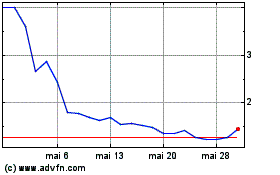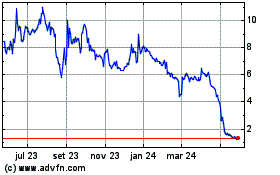Helius Medical Technologies, Inc. (Nasdaq:HSDT) (“Helius” or the
“Company”), a neurotech company focused on delivering a novel
therapeutic neuromodulation approach for balance and gait deficits,
today announced positive preliminary results from its Therapeutic
Experience Program open-label observational study (PoNSTEP) which
evaluates the impact of subjects’ adherence to the Portable
Neuromodulation Stimulator (PoNS®) Therapy program that treat gait
deficit due to multiple sclerosis (“MS”). The study treatment phase
is complete, and the ongoing post-treatment follow-up phase will be
completed by the end of the year, with full results expected to be
released in early 2025.
“As physicians, we often face challenges with
patients embracing the importance of fully complying with their
rehabilitation program” said Antonella Favit-Van Pelt, M.D., Ph.D.,
Helius' Chief Medical Officer, “The PoNSTEP study provides
compelling evidence on how, with any self-directed at home physical
therapy activity, adherence can significantly determine how much
functional improvement any patient can achieve”. We are encouraged
to see the meaningful gait deficit improvements in patients who
were consistently compliant with their therapy regimen.”
Preliminary PoNSTEP Results
The primary endpoint of the study is aimed at
demonstrating improvement in DGI from end of the 2-week supervised
in-clinic treatment phase (Phase 1) to end of the 12-week at-home,
unsupervised treatment phase (Phase 2), relative to subjects’
adherence to PoNS device utilization in their weekly PoNS therapy
program (PoNS Therapy). Forty-three subjects with gait deficit due
to symptoms from multiple sclerosis were enrolled with 41
participants starting the study treatment and 38 participants
completing the 14-week study treatment period who are currently
undergoing post treatment follow-up (Phase 3).
PoNSTEP met the primary endpoint, showing
statistically significant mean improvement in DGI during Phase 2
and a linear relationship between PoNS Therapy adherence and
improvement in DGI scores from end of Phase 1 to end of treatment
at week 14:
- In Phase 1, the average therapy adherence was almost 90% with a
mean improvement of 2.5 points in DGI scores from baseline to the
end of week 2 without, however, a clear correlation between
adherence and DGI improvement (N=41, r=-0.03; p=0.83).
- In Phase 2, the average therapy
adherence was 67% with a mean incremental improvement, at week 14,
of an additional 2.8 points in DGI scores from the improvement
achieved at the end of Phase 1 (paired t-test p<0.0001). In
contrast to Phase 1, improvement in Phase 2 DGI was significantly
moderated by PoNS adherence (N=38, r=0.345; p=0.034).
Over the course of the 14-week treatment (Phase
1 and Phase 2), the average therapy adherence met or exceeded 70%
of the recommended, on label, PoNS Therapy utilization and led to a
mean improvement of 5.0 points (p<0.0001) in DGI from baseline
to the end of the 14-week treatment period moderated by adherence
(r=0.34; p<0.0001). Among 23 participants who met or exceeded
70% therapy adherence, more than 65% experienced a cumulative mean
DGI improvement of at least 5 points and approximately 74% gained
at least 4-point improvement from baseline to end of treatment.
“This data is expected to confirm the importance
of the at-home rehabilitation part of PoNS Therapy, following the
supervised in-clinic treatment, in achieving optimal gait deficit
improvement results,” said Dr. Salvatore Napoli, MD, Medical
Director, Neurology Center of New England. “We are also encouraged
to see the high compliance rates across patients which is likely
supported by the user friendly and straight forward application of
PoNS Therapy.”
The preliminary descriptive analysis of the
active treatment data from Phase 1 and Phase 2 demonstrates that,
overall, 66% of participants gained a clinically meaningful
improvement of at least 4 points in the DGI assessment over the
course of the therapy. In addition, 71% of participants gained at
least a 2-point improvement in DGI in the first 2 weeks of
in-clinic treatment (Phase 1) and 68 % had an incremental DGI
improvement of at least 2 points over the course of the remaining
12 weeks of at-home therapy. In line with the clinical evidence
from PoNS clinical studies and real-world utilization data, 50% of
participants who used PoNS Therapy for the recommended 100-120
min/day, equivalent to 85% and 100% therapy adherence respectively,
achieved over a 6-point improvement in DGI from baseline over 14
weeks of treatment.
Dr. Favit-Van Pelt added, “The study’s
preliminary results provide material confirmatory evidence of the
therapeutic benefits of PoNS Therapy for gait deficit improvement
in people with MS and strengthen the body of clinical evidence
pointing to the importance of utilizing the therapy at the
recommended dose regularly and consistently. The study preliminary
results also highlight the importance of consolidating
neuromodulation-mediated neural changes and the critical role of
PoNS mechanism of neuroplasticity in functional rehabilitation of
gait and balance.”
About PoNS Therapeutic Experience Program
(PoNSTEP)
The Therapeutic Experience Program (“TEP”) is a
Helius-sponsored, open label observational, interventional
multi-center outcome research study designed to assess adherence to
on-label PoNS Therapy for improvement in gait deficits for patients
with multiple sclerosis (“MS”) in a real-world clinical setting.
The study aims to understand better the relationship between
adherence to on label (100-120 minute per day) PoNS Therapy, which
combines the PoNS device with physical therapy, and the therapeutic
outcome on gait deficit improvement over 14 weeks of study
treatment, as measured by changes in the Dynamic Gait Index (DGI)
scores. PoNS Therapy is applied in a supervised clinical setting
for the first two weeks (Phase 1) and, independently, at home for
the remaining 12 weeks (Phase 2). The study also includes a six
month no-treatment follow-up phase aimed at establishing durability
of therapeutic effect (Phase 3).
The primary endpoint of the study is maintenance
of gait improvement from the end of supervised therapy (Phase 1) to
the end of unsupervised therapy (Phase 2) in relation to the
subject’s adherence to PoNS Therapy. The secondary endpoint is
improvement of gait and balance deficit over time and clinical
global impression of change.
The study is currently ongoing at six Centers of
Excellence across the United States, including Neurology Center of
New England in Foxboro (MA), the Shepherd Center in Atlanta (GA),
Montefiore Medical Center (“Montefiore”) in NY (NY), Oregon Health
& Science University (“OHSU”) in Portland (OR), MGH Institute
of Health Professions in Boston (MA), NYU Langone Health in NY
(NY), and recruited 43 MS participants with gait deficit. PoNSTEP
will be completed by the end of 2024 and the Company expects to
announce the full results early in 2025.
About Helius Medical Technologies,
Inc.
Helius Medical Technologies is a leading
neurotech company in the medical device field focused on neurologic
deficits using orally applied technology platform that amplifies
the brain’s ability to engage physiologic compensatory mechanisms
and promote neuroplasticity, improving the lives of people dealing
with neurologic diseases. The Company’s first commercial product is
the Portable Neuromodulation Stimulator. For more information about
the PoNS® or Helius Medical Technologies,
visit www.heliusmedical.com.
About the PoNS Device and PoNS
Therapy
The Portable Neuromodulation Stimulator (“PoNS”)
is an innovative, non-implantable, orally applied therapy that
delivers neurostimulation through a mouthpiece connected to a
controller and it’s used, primarily at home, with physical
rehabilitation exercise, to improve balance and gait. The PoNS
device, which delivers mild electrical impulses to the tongue, is
indicated for use in the United States as a short-term treatment of
gait deficit due to mild-to-moderate symptoms from multiple
sclerosis (“MS”) and is to be used as an adjunct to a supervised
therapeutic exercise program in patients 22 years of age and over
by prescription only.
PoNS has shown effectiveness in treating gait or
balance and a significant reduction in the risk of falling in
stroke patients in Canada, where it received market authorization
for three indications: (i) for use as a short-term treatment (14
weeks) of gait deficit due to mild and moderate symptoms from
stroke and is to be used in conjunction with physical therapy; (ii)
for use as a short-term treatment (14 weeks) of chronic balance
deficit due to mild-to-moderate traumatic brain injury (“mmTBI”)
and is to be used in conjunction with physical therapy; and (iii)
for use as a short-term treatment (14 weeks) of gait deficit due to
mild and moderate symptoms from MS and is to be used in conjunction
with physical therapy. PoNS is also authorized for marketing in
Australia for short term use by healthcare professionals as an
adjunct to a therapeutic exercise program to improve balance and
gait. For more information visit www.ponstherapy.com.
About Neurology Center of New
England
The Neurology Center of New England is a
comprehensive neurological care center devoted to the diagnosis,
care and management of patients with neurological diseases and
syndromes. NCNE manages patients with conditions such as MS,
migraine and other headache syndromes, Parkinson's disease,
neuropathy, seizure disorders and epilepsy, dementia and memory
disorders, numbness, and spasticity/dystonia.
Cautionary Disclaimer
Statement
Certain statements in this news release are not
based on historical facts and constitute forward-looking statements
or forward-looking information within the meaning of the U.S.
Private Securities Litigation Reform Act of 1995 and Canadian
securities laws. All statements other than statements of historical
fact included in this news release are forward-looking statements
that involve risks and uncertainties. Forward-looking statements
are often identified by terms such as “believe,” “expect,”
“continue,” “will,” “goal,” “aim” and similar expressions. Such
forward-looking statements include, among others, statements
regarding the timing of the release of data from the full PoNSTEP
study and the results of the full study.
There can be no assurance that such statements
will prove to be accurate and actual results and future events
could differ materially from those expressed or implied by such
statements. Important factors that could cause actual results to
differ materially from the Company’s expectations include
uncertainties associated with the Company’s capital requirements to
achieve its business objectives, availability of funds, the
Company’s ability to find additional sources of funding,
manufacturing, labor shortage and supply chain risks, including
risks related to manufacturing delays, the Company’s ability to
obtain national Medicare insurance coverage and to obtain a
reimbursement code, the Company’s ability to continue to build
internal commercial infrastructure, secure state distribution
licenses, market awareness of the PoNS device, future clinical
trials and the clinical development process, the product
development process and the FDA regulatory submission review and
approval process, other development activities, ongoing government
regulation, and other risks detailed from time to time in the “Risk
Factors” section of the Company’s Annual Report on Form 10-K for
the year ended December 31, 2023, and its other filings with the
United States Securities and Exchange Commission and the Canadian
securities regulators, which can be obtained from either at
www.sec.gov or www.sedar.com.
The reader is cautioned not to place undue
reliance on any forward-looking statement. The forward-looking
statements contained in this news release are made as of the date
of this news release and the Company assumes no obligation to
update any forward-looking statement or to update the reasons why
actual results could differ from such statements except to the
extent required by law.
Investor Relations ContactPhilip Trip
TaylorGilmartin Groupinvestorrelations@heliusmedical.com
Helius Medical Technolog... (NASDAQ:HSDT)
Gráfico Histórico do Ativo
De Dez 2024 até Jan 2025

Helius Medical Technolog... (NASDAQ:HSDT)
Gráfico Histórico do Ativo
De Jan 2024 até Jan 2025
